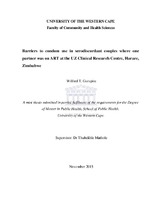| dc.description.abstract | The HIV prevalence rate in Zimbabwe has been estimated at 15% (15 years old and above), which is one of the highest in the world, and HIV/AIDS remains a significant public health problem. The focus of HIV prevention strategies has been on heterosexual transmission since this is the primary driver of the HIV epidemic in Zimbabwe. Heterosexual serodiscordant couples represent an important subpopulation for HIV prevention but are not well studied in Zimbabwe. In Harare almost all serodiscordant couples participating in the HPTN 052 study reported correct and consistent condom use. However, rates of STIs and pregnancies showed that couples in the study continued to have unprotected sex, in-spite of intensive couples’ counselling, quarterly follow up visits and provision of condoms. The aim of this qualitative study was to explore barriers to condom use by these serodiscordant couples in which one partner was on ART in Harare, Zimbabwe. It used a two stage qualitative approach with semi-structured interviews being the primary method of data collection. These interviews were conducted on a sample of five study staff, 15 serodiscordant couples and individuals enrolled in the HPTN 052 study in Harare, Zimbabwe after consent was obtained. Thematic analysis was used to analyse data collected.The study findings showed that partners were in a fairly large age range (30 to 50+ years) with males being slightly older than females. Seven males and five females were HIV positive. Couples had a wide variation in the length of their relationships, from one month to over 15 years as a couple. The study findings also showed that individuals in serodiscordant relationships understood serodiscordance. Problems unique to these couples were identified and broadly categorized as dealing with an HIV positive result, accepting serodiscordance, and difficulty of disclosing serodiscordance to family. Couples also showed understanding of the importance of condom use in a discordant relationship. The most common reason for using condoms was to prevent transmission of HIV to the uninfected partner. The main barriers to condom use were the strong desire to have children, male partner reluctance to use condoms and the influence of the negative partner in determining condom use. Based on these findings, a nuanced approach to prevention strategies, such as condom use and couples counselling and testing, is required. The aim should be to increase understanding of serodiscordance, risk and condom use at all sessions or contacts with couples. | en_US |

